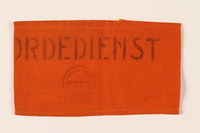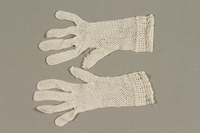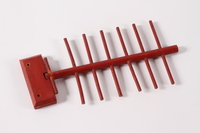Overview
- Description
- Collection of papers, correspondence, and photographs that document the experiences of the Paulus family who hid members of the Nathan family and others in their home in Ermelo, The Netherlands during the Holocaust.
- Credit Line
- United States Holocaust Memorial Museum Collection, Gift of the family of Alice and Paul Paulus
Physical Details
- Extent
-
1 box
Rights & Restrictions
- Conditions on Access
- There are no known restrictions on access to this material.
- Conditions on Use
- The Museum is in the process of determining the possible use restrictions that may apply to material(s) in this collection.
Administrative Notes
- Holder of Originals
-
United States Holocaust Memorial Museum
- Legal Status
- Permanent Collection
- Provenance
- Compiled by Paul and Alice Paulus (donor's parents) during the time period surrounding the Holocaust. The Nathan Family materials were sent to the Paulus family. Donated to the United States Holocaust Memorial Museum in 2010 by the family of Paul and Alice Paulus.
- Record last modified:
- 2023-02-24 13:37:41
- This page:
- https://collections.ushmm.org/search/catalog/irn43411
Download & Licensing
- Copyright Not Evaluated
- Terms of Use
- This record is not digitized and cannot be downloaded online.
In-Person Research
- Request 7 Days in Advance of Visit
- Plan a Research Visit
-
Request in Shapell Center Reading Room
Bowie, MD
Contact Us
Also in Alice and Paul Paulus collection
The collection consists of artifacts, correspondence, documents, oral histories, and photographs relating to the experiences of Aaltje (Alice) and Paul Paulus and Michel and Saartje (Selly) Nathans, who lived in hiding in the Paulus’ home, in Ermelo, Netherlands, during and after the Holocaust.
Date: 1939 September-2002 June

Ordedienst orange armband worn by a Dutch rescuer after the war
Object
Ordedienst [Order Service] armband issued in Harderwijk, Netherlands, and worn by Paul Paulus after liberation in April 1945. It identified Paul as an official civilian authority. During the German occupation of the Netherlands, May 1940-April 1945, Paul and his wife, Aaltje, who lived in Ermelo, aided resistance efforts by hiding Jews in their home. In October 1942, they gave refuge to a Jewish couple, Michel and Saartje Nathans, from Amsterdam, whose young daughter, Anita, was hidden in a different home. Paul built a hidden chamber in the attic bedroom where Michel and Saartje stayed. He built three other hiding places: a dugout under their kitchen floor and two deep holes outside in the nearby woods. Paul played a leadership role for the resistance in his area and the hideouts were used frequently. On April 18, 1945, Ermelo was liberated by British, Irish, and Canadian forces. Michel and Saartje reunited with Anita and returned to Amsterdam.

Pair of white lace gloves crocheted by a Dutch Jewish woman while living in hiding
Object
White lace gloves crocheted by Saartje Nathans while she lived in hiding in the home of Aaltje and Paul Paulus in Ermelo, Netherlands, from October 1942-April 1945. She made over forty pairs of gloves, which the Paulus family used as gifts. In 1942, after nearly two years of occupation by the Germans, deportations were becoming frequent. Saartje and Michel decided to send their two year old daughter, Anita, to live with a non-Jewish family in the countryside. That October, they left Amsterdam and were offered a hiding place with the Paulus family. They lived all day in a small attic bedroom; Paul built a hidden compartment in the room when the Germans intensified their searches for hidden Jews. Paul built three other hiding spaces: a dugout under the kitchen floor, and two deep holes outside in the nearby woods. Paul played a leadership role in the resistance in the area and the hiding spaces were used often. On April 18, 1945, Ermelo was liberated by British, Irish, and Canadian forces. Saartje and Michel reunited with Anita and returned to Amsterdam.

Red wooden tie rack made by a Dutch Jew while living in hiding
Object
Small wooden tie rack constructed by Michel Nathans while he lived in hiding in the home of Aaltje and Paul Paulus in Ermelo, Netherlands, from October 1942-April 1945. The tie racks he made were then sold by Paul. In 1942, after nearly two years of occupation by the Germans, deportations were becoming frequent. Michel and Saartje decided to send their two year old daughter, Anita, to live with a non-Jewish family in the countryside. That October, they left Amsterdam and were offered a hiding place with the Paulus family. They lived all day in a small attic bedroom; Paul built a hidden compartment in the room when the Germans intensified their searches for hidden Jews. Paul built three other hiding spaces: a dugout under the kitchen floor, and two deep holes outside in the nearby woods. Paul played a leadership role in the resistance in the area and the hiding spaces were used often. On April 18, 1945, Ermelo was liberated by British, Irish, and Canadian forces. Saartje and Michel reunited with Anita and returned to Amsterdam.

Oral history interview with Alice Paulus and Michel Nathan
Oral History
Alice Paulus discusses the experiences of her family who hid members of the Nathan family and others in their home in Ermelo, The Netherlands during the Holocaust. In the second video segment, Alice Paulus and Michel Nathan discuss their wartime experiences together.



